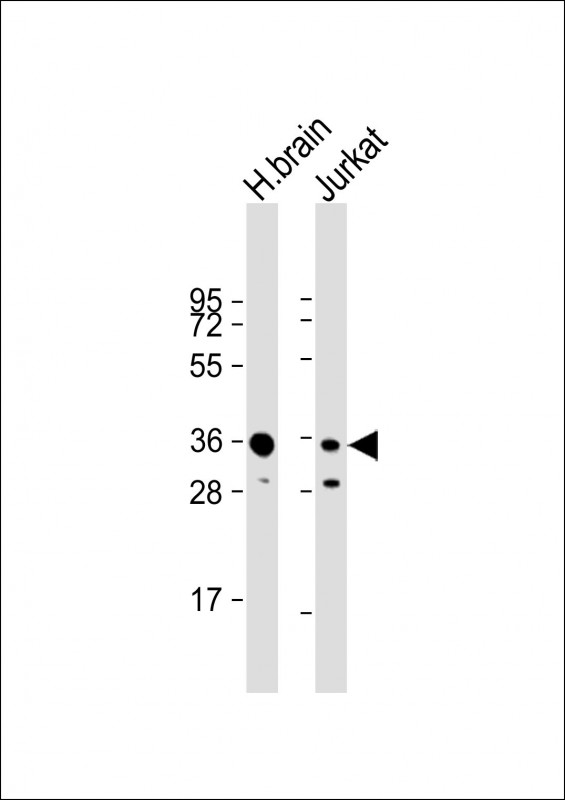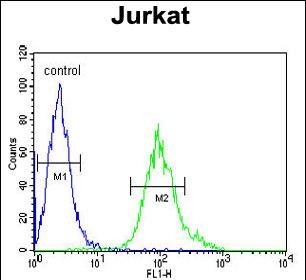GNB1 Antibody (N-term)
Affinity Purified Rabbit Polyclonal Antibody (Pab)
- SPECIFICATION
- CITATIONS: 3
- PROTOCOLS
- BACKGROUND

Application
| FC, WB, E |
|---|---|
| Primary Accession | P62873 |
| Other Accession | P79959, P54311, P62874, Q6PH57, Q6TMK6, P62871 |
| Reactivity | Human |
| Predicted | Bovine, Hamster, Zebrafish, Mouse, Rat, Xenopus |
| Host | Rabbit |
| Clonality | Polyclonal |
| Isotype | Rabbit IgG |
| Calculated MW | 37377 Da |
| Antigen Region | 1-30 aa |
| Gene ID | 2782 |
|---|---|
| Other Names | Guanine nucleotide-binding protein G(I)/G(S)/G(T) subunit beta-1, Transducin beta chain 1, GNB1 |
| Target/Specificity | This GNB1 antibody is generated from rabbits immunized with a KLH conjugated synthetic peptide between 1-30 amino acids from the N-terminal region of human GNB1. |
| Dilution | FC~~1:10~50 WB~~1:1000 E~~Use at an assay dependent concentration. |
| Format | Purified polyclonal antibody supplied in PBS with 0.09% (W/V) sodium azide. This antibody is purified through a protein A column, followed by peptide affinity purification. |
| Storage | Maintain refrigerated at 2-8°C for up to 2 weeks. For long term storage store at -20°C in small aliquots to prevent freeze-thaw cycles. |
| Precautions | GNB1 Antibody (N-term) is for research use only and not for use in diagnostic or therapeutic procedures. |
| Name | GNB1 (HGNC:4396) |
|---|---|
| Function | Guanine nucleotide-binding proteins (G proteins) are involved as a modulator or transducer in various transmembrane signaling systems (PubMed:29925951, PubMed:33762731, PubMed:34239069, PubMed:35610220, PubMed:35714614, PubMed:35835867, PubMed:36087581, PubMed:36989299, PubMed:37327704, PubMed:37935376, PubMed:37935377, PubMed:37963465, PubMed:37991948, PubMed:38168118, PubMed:38552625). The beta and gamma chains are required for the GTPase activity, for replacement of GDP by GTP, and for G protein-effector interaction (PubMed:29925951, PubMed:33762731, PubMed:34239069, PubMed:35610220, PubMed:35714614, PubMed:35835867, PubMed:36087581, PubMed:36989299, PubMed:37327704, PubMed:37935376, PubMed:37935377, PubMed:37963465, PubMed:38168118, PubMed:38552625). |

Provided below are standard protocols that you may find useful for product applications.
Background
GNB1 integrate signals between receptors and effector proteins, are composed of an alpha, a beta, and a gamma subunit. These subunits are encoded by families of related genes. This gene encodes a beta subunit. Beta subunits are important regulators of alpha subunits, as well as of certain signal transduction receptors and effectors. This protein uses alternative polyadenylation signals.
References
Ahmed, S.M., et al. J. Biol. Chem. 285(9):6538-6551(2010)
Gutman, O., et al. J. Biol. Chem. 285(6):3905-3915(2010)
Knezevic, N., et al. J. Exp. Med. 206(12):2761-2777(2009)
If you have used an Abcepta product and would like to share how it has performed, please click on the "Submit Review" button and provide the requested information. Our staff will examine and post your review and contact you if needed.
If you have any additional inquiries please email technical services at tech@abcepta.com.














 Foundational characteristics of cancer include proliferation, angiogenesis, migration, evasion of apoptosis, and cellular immortality. Find key markers for these cellular processes and antibodies to detect them.
Foundational characteristics of cancer include proliferation, angiogenesis, migration, evasion of apoptosis, and cellular immortality. Find key markers for these cellular processes and antibodies to detect them. The SUMOplot™ Analysis Program predicts and scores sumoylation sites in your protein. SUMOylation is a post-translational modification involved in various cellular processes, such as nuclear-cytosolic transport, transcriptional regulation, apoptosis, protein stability, response to stress, and progression through the cell cycle.
The SUMOplot™ Analysis Program predicts and scores sumoylation sites in your protein. SUMOylation is a post-translational modification involved in various cellular processes, such as nuclear-cytosolic transport, transcriptional regulation, apoptosis, protein stability, response to stress, and progression through the cell cycle. The Autophagy Receptor Motif Plotter predicts and scores autophagy receptor binding sites in your protein. Identifying proteins connected to this pathway is critical to understanding the role of autophagy in physiological as well as pathological processes such as development, differentiation, neurodegenerative diseases, stress, infection, and cancer.
The Autophagy Receptor Motif Plotter predicts and scores autophagy receptor binding sites in your protein. Identifying proteins connected to this pathway is critical to understanding the role of autophagy in physiological as well as pathological processes such as development, differentiation, neurodegenerative diseases, stress, infection, and cancer.


